1997 TOYOTA RAV4 ECU
[x] Cancel search: ECUPage 29 of 198
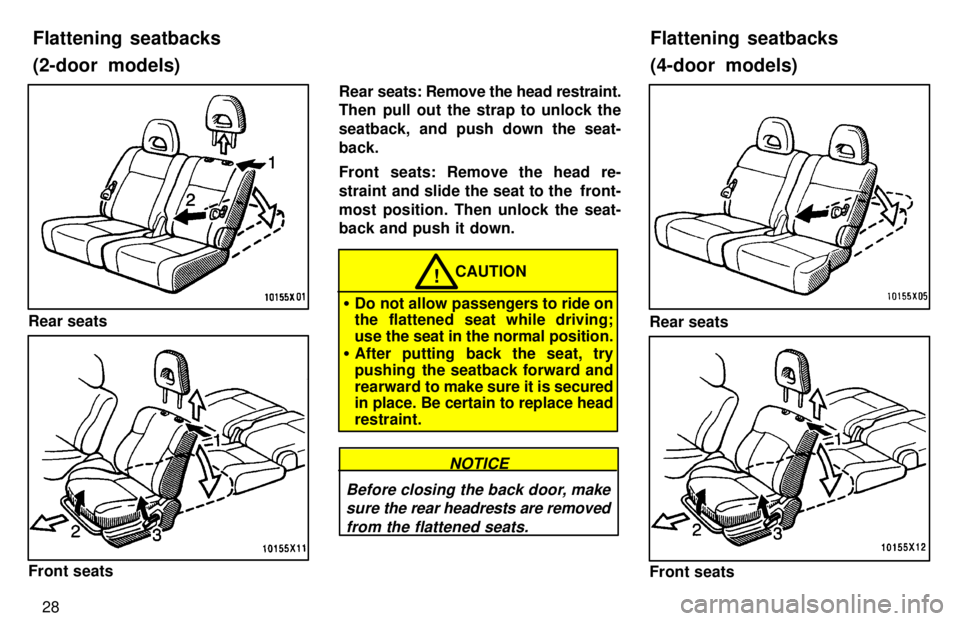
28
Rear seats
Front seatsRear
seats: Remove the head restraint.
Then pull out the strap to unlock the
seatback, and push down the seat-back.
Front seats: Remove the head re-
straint and slide the seat to the front-
most position. Then unlock the seat- back and push it down.
CAUTION!
� Do not allow passengers to ride on
the flattened seat while driving;
use the seat in the normal position.
� After putting back the seat, try
pushing the seatback forward and
rearward to make sure it is secured
in place. Be certain to replace headrestraint.
Before closing the back door, make
sure the rear headrests are removed
from the flattened seats.
NOTICE
Rear seats
Front seats
Flattening seatbacks (2-door models)
Flattening seatbacks(4-door models)
Page 30 of 198
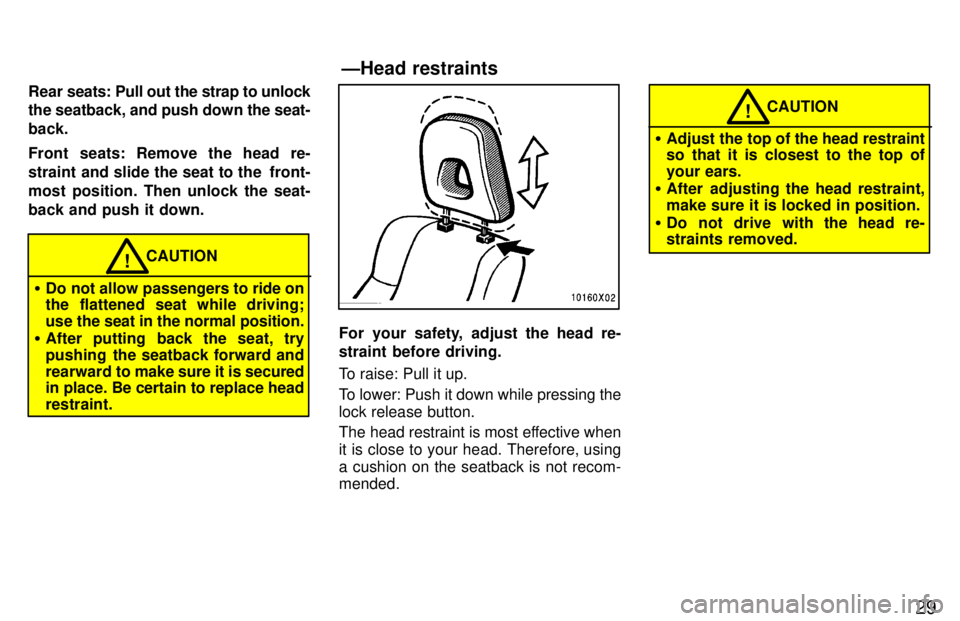
29
Rear
seats: Pull out the strap to unlock
the seatback, and push down the seat- back.
Front seats: Remove the head re-
straint and slide the seat to the front-
most position. Then unlock the seat-back and push it down.
CAUTION!
� Do not allow passengers to ride on
the flattened seat while driving;
use the seat in the normal position.
� After putting back the seat, try
pushing the seatback forward and
rearward to make sure it is secured
in place. Be certain to replace headrestraint.
For your safety, adjust the head re-
straint before driving.
To raise: Pull it up.
To lower: Push it down while pressing the lock release button.
The head restraint is most effective when
it is close to your head. Therefore, usinga cushion on the seatback is not recom- mended.
CAUTION!
� Adjust the top of the head restraint
so that it is closest to the top of
your ears.
� After adjusting the head restraint,
make sure it is locked in position.
� Do not drive with the head re-
straints removed.
ÐHead restraints
Page 31 of 198
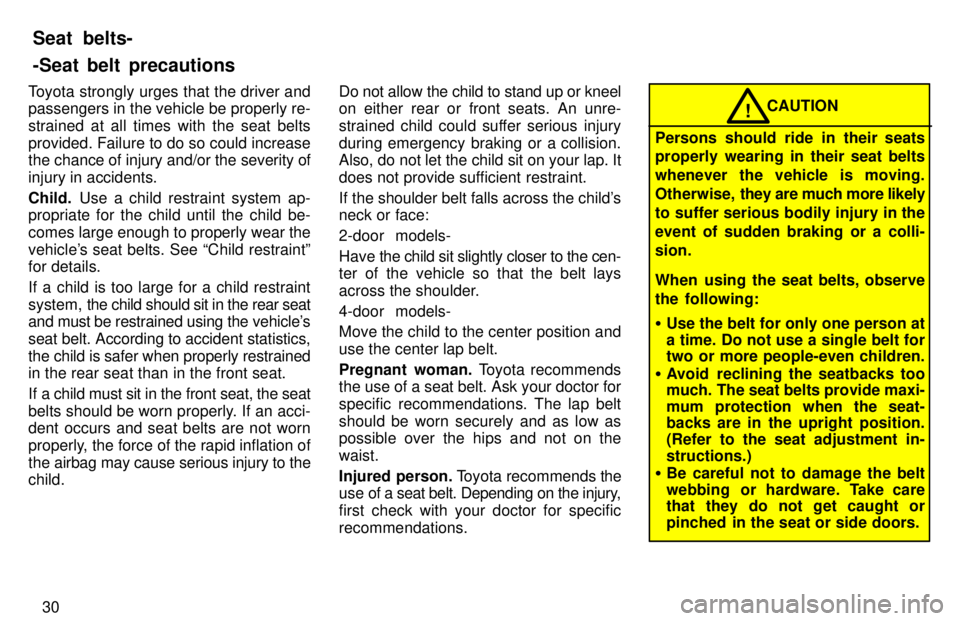
30
Toyota strongly urges that the driver and passengers in the vehicle be properly re- strained at all times with the seat belts
provided. Failure to do so could increase
the chance of injury and/or the severity of
injury in accidents. Child.
Use a child restraint system ap-
propriate for the child until the child be-
comes large enough to properly wear the
vehicle's seat belts. See Child restraintº
for details.
If a child is too large for a child restraint
system, the child should sit in the rear seat
and must be restrained using the vehicle's
seat belt. According to accident statistics,the child is safer when properly restrained
in the rear seat than in the front seat.
If a child must sit in the front seat, the seat
belts should be worn properly. If an acci-
dent occurs and seat belts are not worn
properly, the force of the rapid inflation of
the airbag may cause serious injury to the child. Do not allow the child to stand up or kneel
on either rear or front seats. An unre-
strained child could suffer serious injury
during emergency braking or a collision.
Also, do not let the child sit on your lap. It
does not provide sufficient restraint.
If the shoulder belt falls across the child's neck or face: 2-door models-
Have
the child sit slightly closer to the cen-
ter of the vehicle so that the belt lays
across the shoulder. 4-door models- Move the child to the center position and use the center lap belt.
Pregnant woman. Toyota recommends
the use of a seat belt. Ask your doctor for
specific recommendations. The lap belt
should be worn securely and as low as
possible over the hips and not on the waist.
Injured person. Toyota recommends the
use of a seat belt. Depending on the injury,
first check with your doctor for specificrecommendations.
CAUTION!
Persons should ride in their seats
properly wearing in their seat belts
whenever the vehicle is moving.
Otherwise, they are much more likely
to suffer serious bodily injury in theevent of sudden braking or a colli-sion.
When using the seat belts, observe
the following: � Use the belt for only one person at a time. Do not use a single belt for
two or more people-even children.
� Avoid reclining the seatbacks too
much. The seat belts provide maxi-
mum protection when the seat-
backs are in the upright position.
(Refer to the seat adjustment in-structions.)
� Be careful not to damage the belt
webbing or hardware. Take care
that they do not get caught or
pinched in the seat or side doors.
Seat belts- -Seat belt precautions
Page 32 of 198
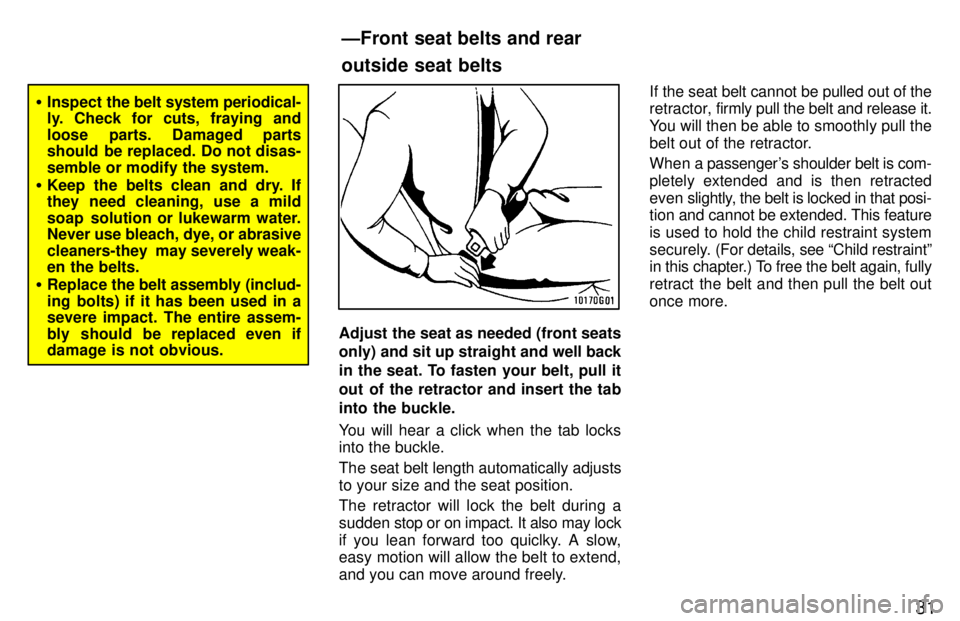
31
�Inspect the belt system periodical-
ly. Check for cuts, fraying and
loose parts. Damaged parts
should be replaced. Do not disas- semble or modify the system.
� Keep the belts clean and dry. If
they need cleaning, use a mild
soap solution or lukewarm water.
Never use bleach, dye, or abrasive
cleaners-they may severely weak-
en the belts.
� Replace the belt assembly (includ-
ing bolts) if it has been used in a
severe impact. The entire assem-
bly should be replaced even if
damage is not obvious.
Adjust the seat as needed (front seats only) and sit up straight and well back
in the seat. To fasten your belt, pull it
out of the retractor and insert the tab
into the buckle.
You will hear a click when the tab locks into the buckle.
The seat belt length automatically adjusts
to your size and the seat position.
The retractor will lock the belt during a
sudden stop or on impact. It also may lock
if you lean forward too quiclky. A slow, easy motion will allow the belt to extend,
and you can move around freely. If the seat belt cannot be pulled out of the
retractor,
firmly pull the belt and release it.
You will then be able to smoothly pull the
belt out of the retractor.
When a passenger's shoulder belt is com-
pletely extended and is then retracted
even slightly, the belt is locked in that posi-
tion and cannot be extended. This feature
is used to hold the child restraint system
securely. (For details, see Child restraintº
in this chapter.) To free the belt again, fully
retract the belt and then pull the belt out
once more.
ÐFront seat belts and rear outside seat belts
Page 40 of 198
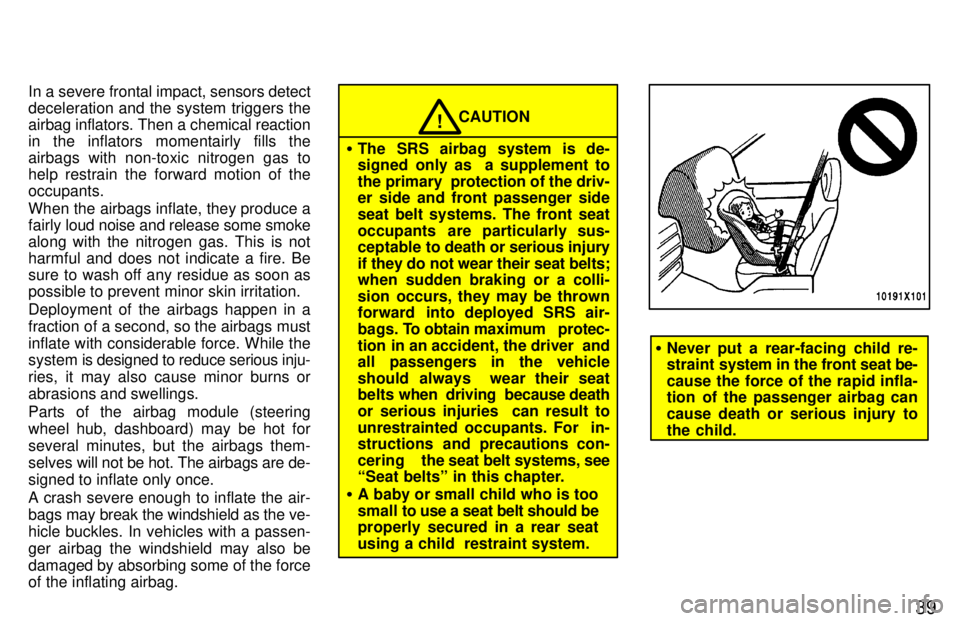
39
In a severe frontal impact, sensors detect
deceleration and the system triggers the
airbag inflators. Then a chemical reaction
in the inflators momentairly fills the
airbags with non-toxic nitrogen gas to
help restrain the forward motion of theoccupants. When the airbags inflate, they produce a fairly
loud noise and release some smoke
along with the nitrogen gas. This is notharmful and does not indicate a fire. Be
sure to wash off any residue as soon as
possible to prevent minor skin irritation.
Deployment of the airbags happen in a
fraction of a second, so the airbags must
inflate with considerable force. While the
system is designed to reduce serious inju-
ries, it may also cause minor burns or
abrasions and swellings.
Parts of the airbag module (steering
wheel hub, dashboard) may be hot forseveral minutes, but the airbags them-selves w ill not be hot. The airbags are de-
signed to inflate only once.
A crash severe enough to inflate the air-
bags may break the windshield as the ve-
hicle buckles. In vehicles with a passen-ger airbag the windshield may also be
damaged by absorbing some of the force
of the inflating airbag.
CAUTION!
� The SRS airbag system is de-
signed only as a supplement to
the primary protection of the driv-
er side and front passenger side seat belt systems. The front seat
occupants are particularly sus-
ceptable to death or serious injury
if they do not wear their seat belts;
when sudden braking or a colli-
sion occurs, they may be thrown
forward into deployed SRS air-
bags. To obtain maximum protec-
tion in an accident, the driver and
all passengers in the vehicle
should always wear their seat
belts when driving because death
or serious injuries can result to
unrestrainted occupants. For in-
structions and precautions con-
cering the seat belt systems, see
Seat beltsº in this chapter.
� A baby or small child who is too
small to use a seat belt should be
properly secured in a rear seat
using a child restraint system.
�Never put a rear-facing child re-
straint system in the front seat be-
cause the force of the rapid infla-
tion of the passenger airbag can cause death or serious injury to
the child.
Page 45 of 198
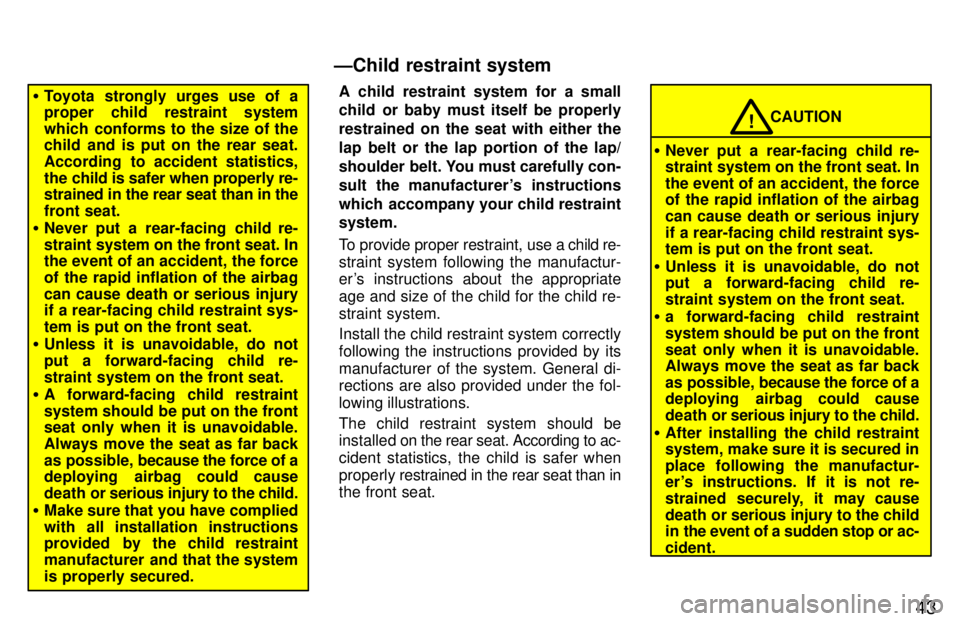
43
�Toyota strongly urges use of a
proper child restraint system
which conforms to the size of the
child and is put on the rear seat.
According to accident statistics,
the child is safer when properly re- strained in the rear seat than in the
front seat.
� Never put a rear-facing child re-
straint system on the front seat. In
the event of an accident, the force
of the rapid inflation of the airbag
can cause death or serious injury
if a rear-facing child restraint sys- tem is put on the front seat.
� Unless it is unavoidable, do not
put a forward-facing child re-
straint system on the front seat.
� A forward-facing child restraint
system should be put on the front
seat only when it is unavoidable.
Always move the seat as far back
as possible, because the force of a
deploying airbag could cause
death or serious injury to the child.
� Make sure that you have complied
with all installation instructions
provided by the child restraint
manufacturer and that the systemis properly secured. A child restraint system for a small
child or baby must itself be properly
restrained on the seat with either the
lap belt or the lap portion of the lap/
shoulder belt. You must carefully con-
sult the manufacturer's instructions
which accompany your child restraint system.
To provide proper restraint, use a
child re-
straint system following the manufactur-
er's instructions about the appropriate
age and size of the child for the child re-
straint system. Install the child restraint system correctly
following the instructions provided by its
manufacturer of the system. General di- rections are also provided under the fol-
lowing illustrations.
The child restraint system should be
installed on the rear seat. According to ac-
cident statistics, the child is safer when
properly restrained in the rear seat than in
the front seat.
CAUTION!
� Never put a rear-facing child re-
straint system on the front seat. In
the event of an accident, the force
of the rapid inflation of the airbag
can cause death or serious injury
if a rear-facing child restraint sys- tem is put on the front seat.
� Unless it is unavoidable, do not
put a forward-facing child re-
straint system on the front seat.
� a forward-facing child restraint
system should be put on the front
seat only when it is unavoidable.
Always move the seat as far back
as possible, because the force of a
deploying airbag could cause
death or serious injury to the child.
� After installing the child restraint system, make sure it is secured in
place following the manufactur-
er's instructions. If it is not re-
strained securely, it may cause
death or serious injury to the child
in the event of a sudden stop or ac- cident.
ÐChild restraint system
Page 46 of 198

44
When not using the child restraint system, keep it secured with the seat belt. This
will
prevent it from injuring passengers in the event of a sudden stop or accident.
Your vehicle has anchors for securing the
top strap of a child restraint system. The
anchor nuts are welded beneath the sheet
metal to permit installation of an anchor
bracket for a child restraint system.
To install an anchor bracket, use an 8 mm
X 30 mm X 1.25 mm coarse thread metric
bolt and a 10 mm (0.4 in.) spacer. Notethat the bolts accompanying many child
restraint systems are not metric. You can
damage the anchor nuts on your vehicle
if you force bolts with different thread into the anchor nuts.
For instructions about how to install the
anchor bracket, see Top strap anchors
and locationsº.
If your child restraint system does not pro-
vide any of the necessary parts, you can
purchase the following items from your
Toyota dealer. � CRS installation kit
(Part No. 04731-22012) -contains 1
bolt, 3 types of spacers and 1 locking clip.
� Bolt (Part No. 91511-60830) Child restraint systems are classified into the following 3 types depending on the
childs age and size.
(A) Infant seat
(B) Convertible seat
(C) Booster seat
Install the child restraint system following the instructions provided by its manufac-
turer.
ÐTypes of child restraint system
Page 48 of 198
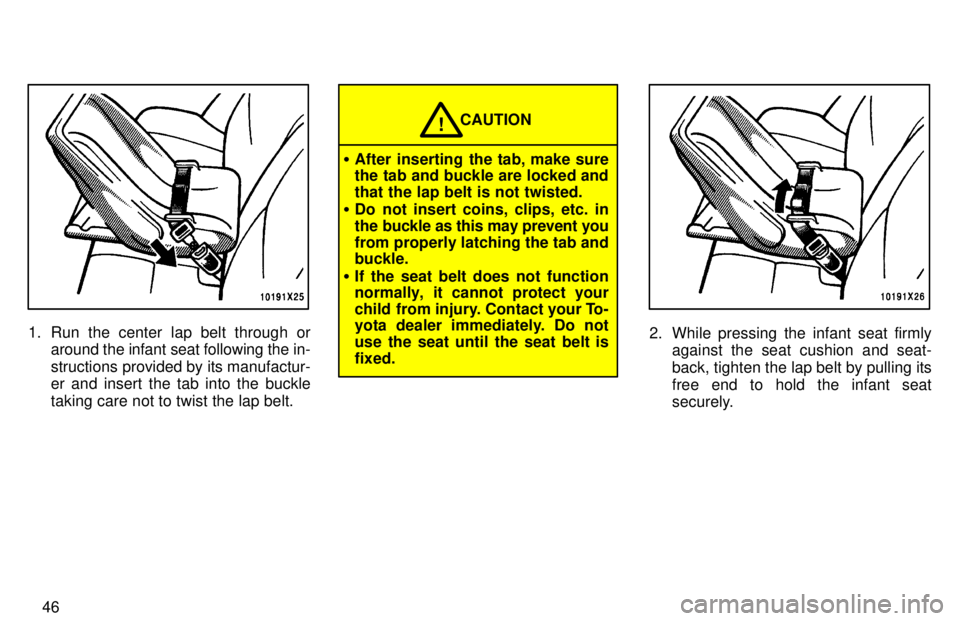
46
1. Run the center lap belt through oraround the infant seat following the in-
structions provided by its manufactur- er and insert the tab into the buckle taking care not to twist the lap belt.
CAUTION!
� After inserting the tab, make sure
the tab and buckle are locked and that the lap belt is not twisted.
� Do not insert coins, clips, etc. in
the buckle as this may prevent you
from properly latching the tab and buckle.
� If the seat belt does not function
normally, it cannot protect your
child from injury. Contact your To-
yota dealer immediately. Do not
use the seat until the seat belt isfixed.
2. While pressing the infant seat firmly
against the seat cushion and seat-
back, tighten the lap belt by pulling its
free end to hold the infant seat
securely.